
Rediscovering Japan

Rediscovering Japan
Travel (Wakayama/Mie Part 3 (Kouyasan))

by tomizuta
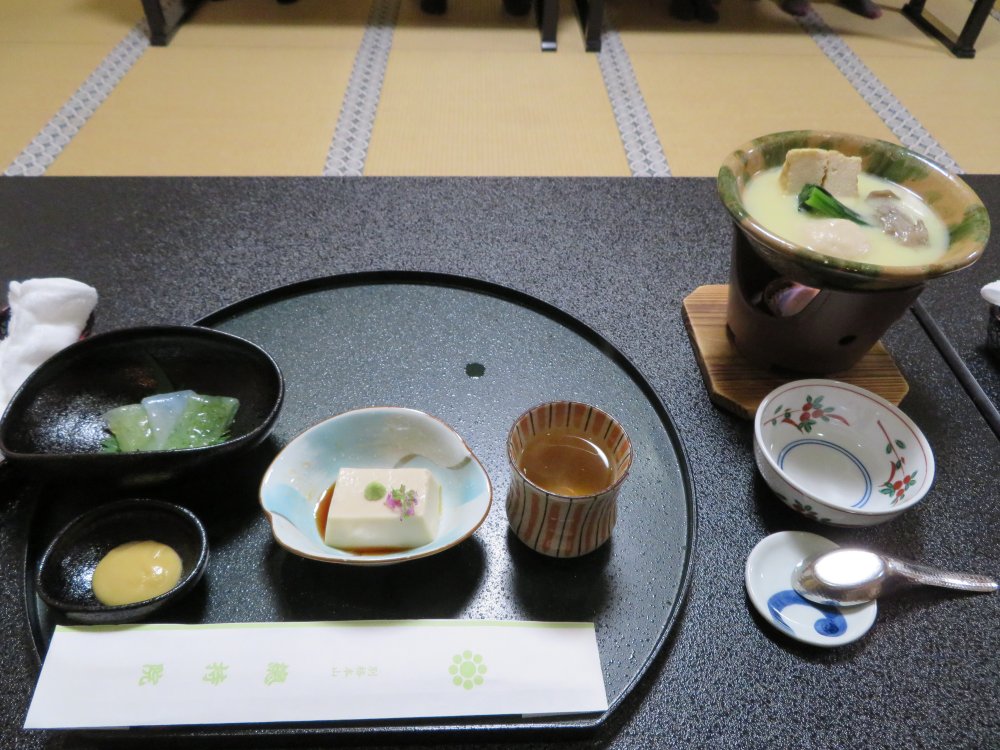
The start of a vegetarian course menu (Shoujin-ryouri) at Kouyasan. From left, Kon-nyaku (made from a root vegetable as sashimi with the miso dip, sesame tofu and a miso based vegetable pot
The following Monday, we visited Kumano-honguu, the last of the three shrines composing Kumano Sanzan. It was about an hour’s tour north-west by bus from Katsuura. The current Kumano-honguu is on an elevated area, but originally the shrine stood on a sandbank called Ooyunohara in the Kumano River. The flooding in 1889 destroyed two of the three shrines (Upper, Middle and Lower) composing the shrine and it was only the Upper shrine that survived and transferred to the current site in 1891.
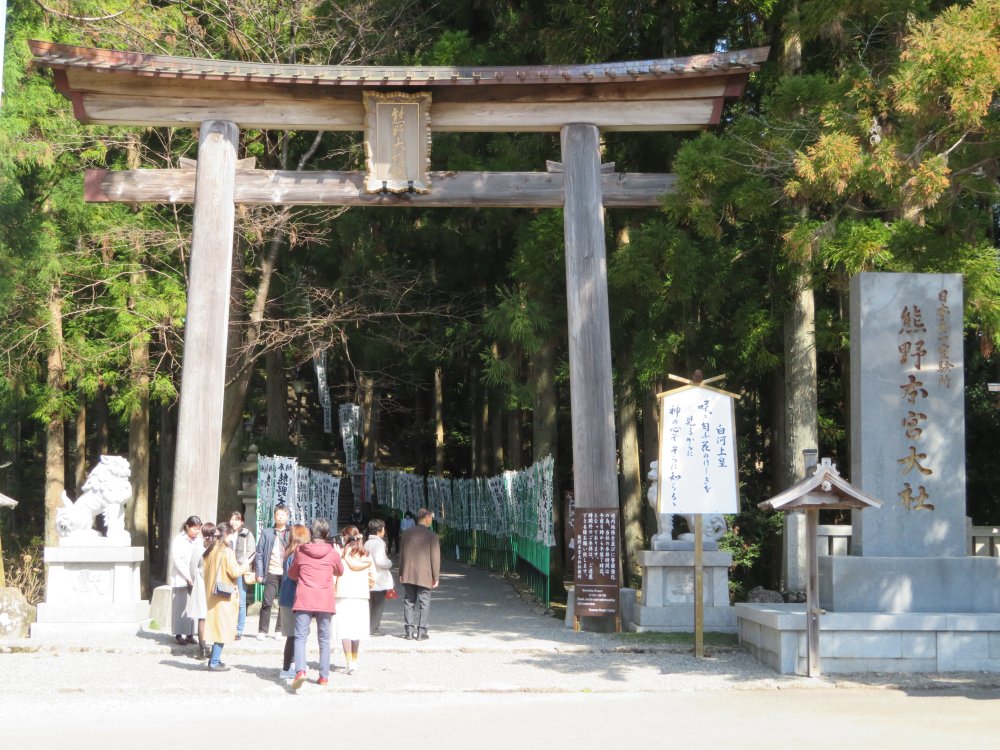
The entrance gate to Kumano-honguu
The deity worshipped is God Ketsumimiko, who is God Susanoo, the younger brother of Goddess Amaterasu. It is 158 steps up to the shrine, but just before the entrance gate to the Goshaden (main shrine) we noticed a signboard on the left that told us that God Susanoo was a wood God. Wood is Ki in Japanese and that is where the name Kii derived it said.

We went up 158 steps to reach the Goshadenlevel.
Kumano-honguu is the first of the three shrines of Kumano Sanzan that you reach on the Nakahechi pilgrimage route coming from Kyoto. I’m sure our ancestors were overwhelmed by the natural beauty of this sacred area after the long journey.
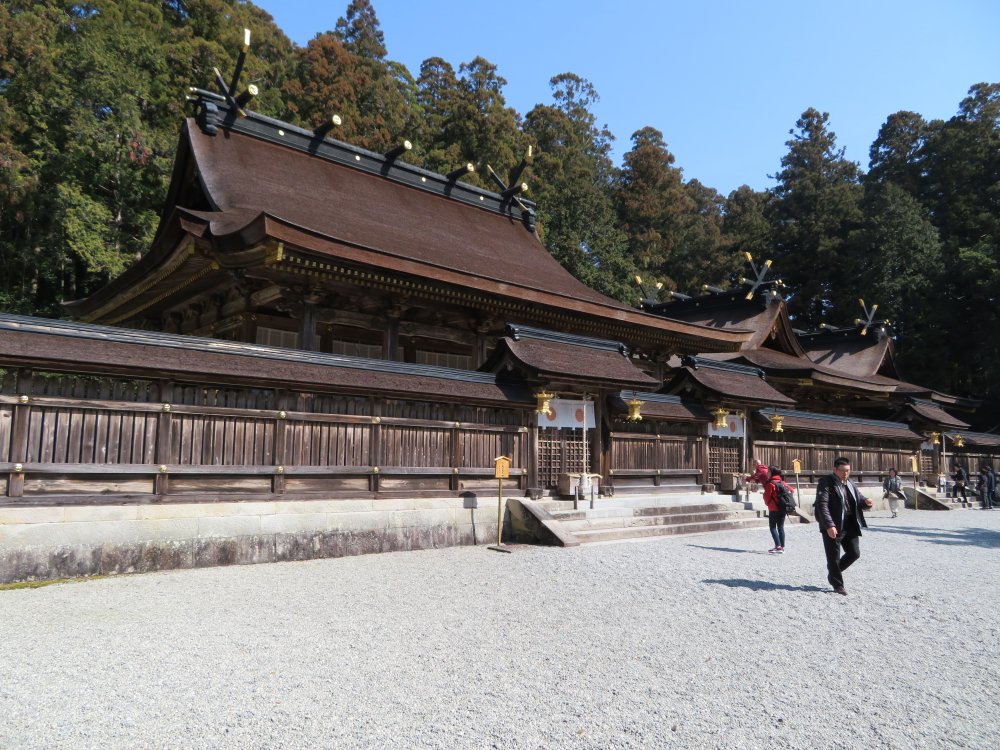
A view of the main sections of the Goshaden (main shrine) of Kumano-honguu.
There are two interesting objects to see in the grounds in front of the Goshaden. One is an evergreen tree called Tarayou belonging to the holly species. You can write on the back of the leaves by just scratching, which is why the tree has been named the “postcard tree”. And next to the tree is a postbox with a Yatagarasu on top. Because Yatagarasu is believed to be the messenger for God Susanoo and Tarayou is a “postcard tree”, someone must have developed the idea to combine them all together. I don’t think you can mail a postcard from the postbox.
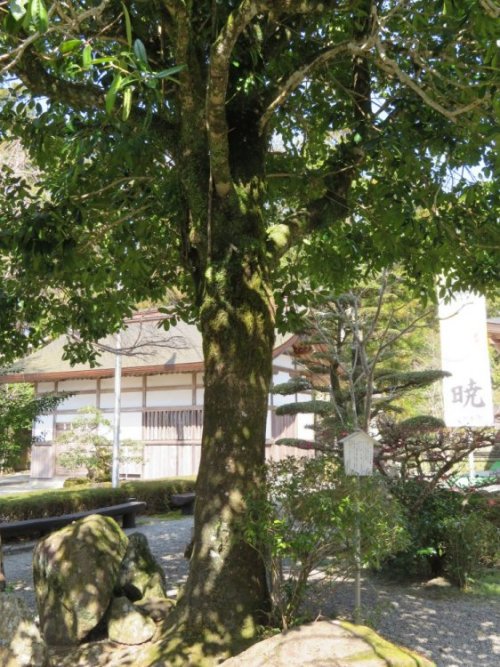

The Tarayou tree and the Yatagarasu post box
Our next and final destination of the tour was Kouyasan a further 40 minutes’ drive from Kumano-honguu. Kouyasan is also a component of the Sacred Sites and Pilgrimage Routes in the Kii Mountains designated as a World Heritage in 2004.
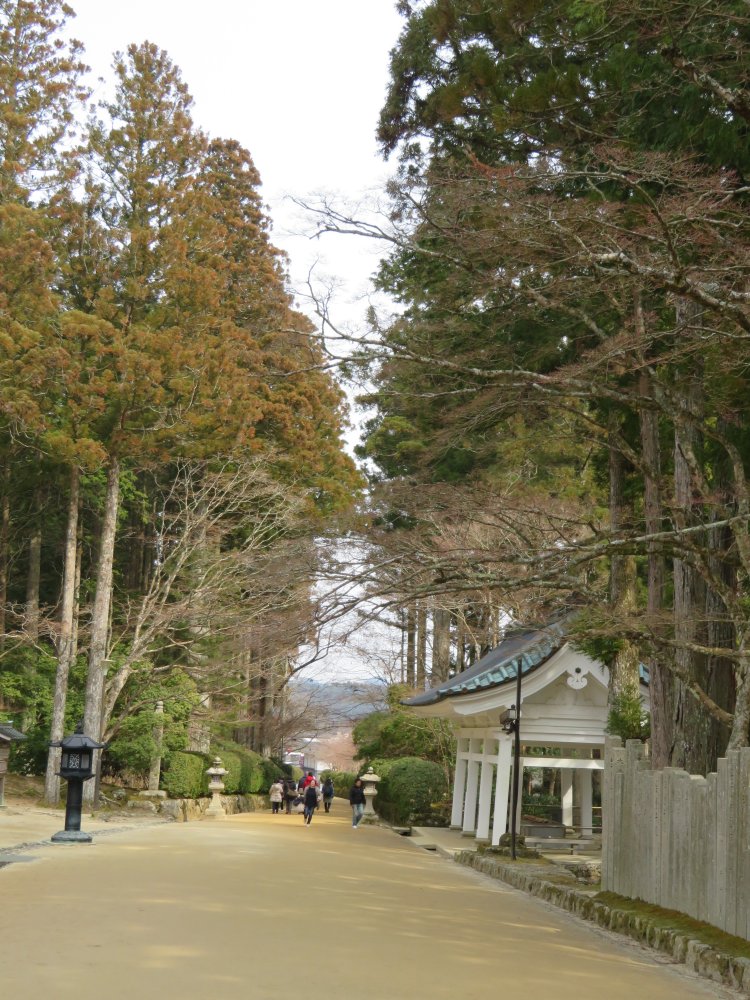
From the historical center Daijougaran towards Kongoubuji via Jabaramichi (Snake belly path)
As I explained in Part 1, Buddhism was imported to Japan in the 6th century, and in the early 9th century a Buddhist Priest Kuukai established the Shingon sect of esoteric Buddhism. Shingon means “true word”. Kuukai encouraged the pursuit of the true word through spiritual training and stoicism and selected Kouyasan as the ideal place to pursue this and founded Kongoubuji Temple. San in Kouyasan is “mountain” in Chinese Kanji characters, like in Fujisan (Mount Fuji). However there is no mountain called Kouyasan. Kouyasan is a plateau at about 800 meters above sea level and surrounded by eight mountains. There are a couple of explanations why Kuukai opened Kouyasan as a sacred site for Buddhism. One legend says that he prayed to find a place suitable to found a temple in Japan while he was in China studying. He threw a Buddhism ritual tool which flew over the sea to Japan. He found the tool upon his return to Japan stuck in a pine tree in Kouyasan. Another suggestion is that he opened Kouyasan because it is surrounded by eight mountains very much resembling a sacred lotus flower. There is also a legend that Kuukai was led to Kouyasan by the local God Karibamyoujin with two dogs and dressed as a huntsman. This last legend is interesting in that it tries to explain that the local Gods approved of Kuukai entering Kouyasan. In the Danjou-garan (temple complex) that I will talk about shortly, there is a shrine dedicated to Karibamyoujin and his mother Goddess Niutsuhime, the sister of Goddess Amaterasu. This is another example of the Shinto-Buddhism fusion.
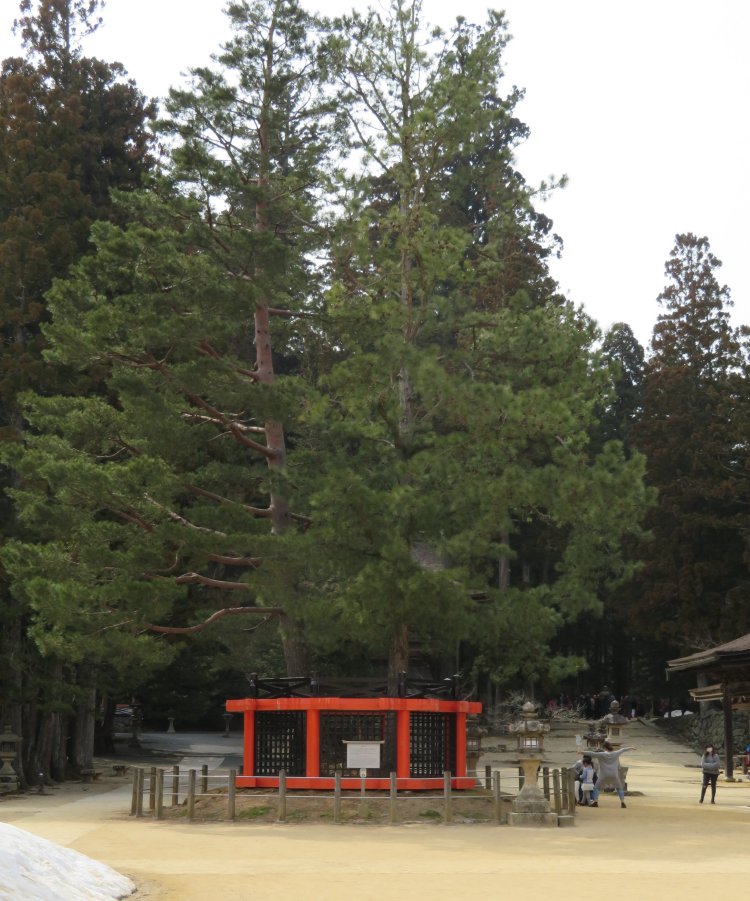
The "Sanko (ritual tool)"pine tree in the Daijougaran area. Legend says that the Sanko Kuukai threw from China got stuck in the tree
It was close to one o’clock when we arrived at Kouyasan. Kouuyasan houses over one hundred Buddhist temples and at least half of them provide food and lodging to visitors. These temples are called Shukubou. We went to one Shukubou, Soujiin for lunch. The Shukubous serve a vegetarian menu called Shoujinryouri based on Buddhhist belief that prohibits the taking of life. As vegetables usually have some harshness, cooking to remove the harshness as well as preserve the food was developed. From soya beans, tofu and miso was made. Miso uses a lot of salt, and so did the cooking of many dishes of shoujinryouri. This suited the needs of the samurai and commoners that used a lot of energy in their daily lives. Many dishes were imported into kaisekiryouri, which is a meal served after a tea ceremony, and eventually Japanese cooking in general.
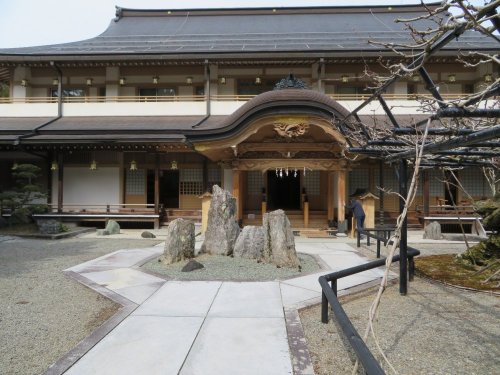
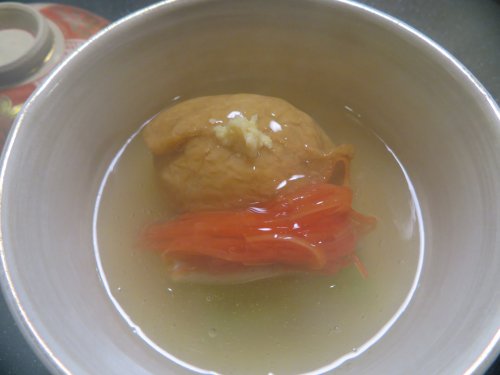
We lunched at a shukubou, Soujiin (left). The next dish of the shoujinryouri was Hiryuuzu (tofu and root vegetables mixed into a ball and fried) stewed in a thick soup, a shoujinryouri classic (right).
We thoroughly enjoyed the Shoujinryouri. I was a bit surprised when the server asked what drinks we wanted to have and responded to a tourist’s question that several brands of beer is available. Kouyasan has kept a stoic tradition. Our guide informed us that there is no meat or fish shop in the area, and it was only recently that a convenience store was admitted in the area. I wondered if the convenience store carried any cheese or ham as they would elsewhere. I do understand that some Shukubous are more relaxed to visitors and offer alcohols and sashimi.

Steamed rice with green peas with miso soup and assorted pickles, followed by apple jelly
We had a young but experienced official Kouyasan guide that seemed to know all the Kouyasan people. I understand that English speaking guides are also available. The history of Kouyasan is long and complicated, so it is advisable to have a good guide. If you have the chance to read this article before your visit, I am sure that it will help in your listening to your guide. We were first guided to the Danjou-garan complex. Kouyasan is really a Temple city as Cambridge and Oxford are university cities. The entire Kouyasan is what composes Kongoubuji Temple that was founded by Kuukai, and the Danjou-garan is the equivalent of a Hondou (main temple) of Kouyasan. I explained that there are over one hundred Buddhist temples within Kouyasan. From these temples a Houin, regarded as the successor of Kuukai, is elected to serve as the Houin on a one year term to lead important rituals in Kongoubuji Temple.
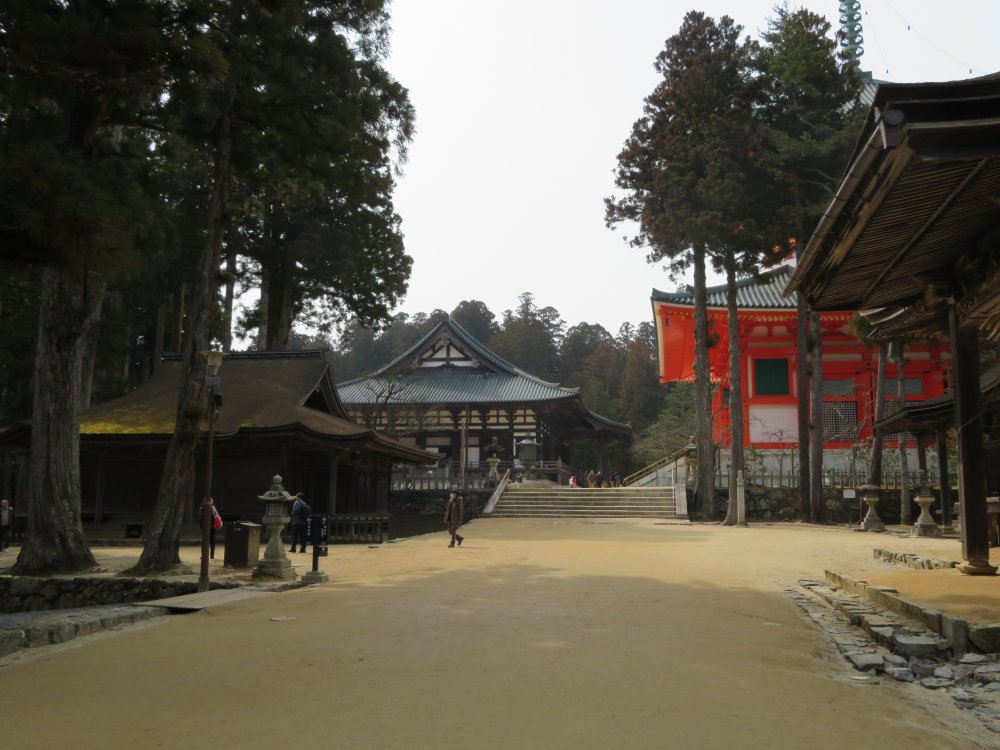
The Danjougaran of Kouyasan. The building in front is the Kondou (main temple).
We went past the Fudoudou which was built in the Kamakura era (12th to 14th century) and has been designated as a national treasure. It has features of a nobleman’s house of the late Heian period. The exact role of the building is unknown, but is so named as it housed a sculpture of Fudoumyouou by the master sculptor Unkei of the Kamakura era. A feature of the building is its different roof and building style of the four sides.
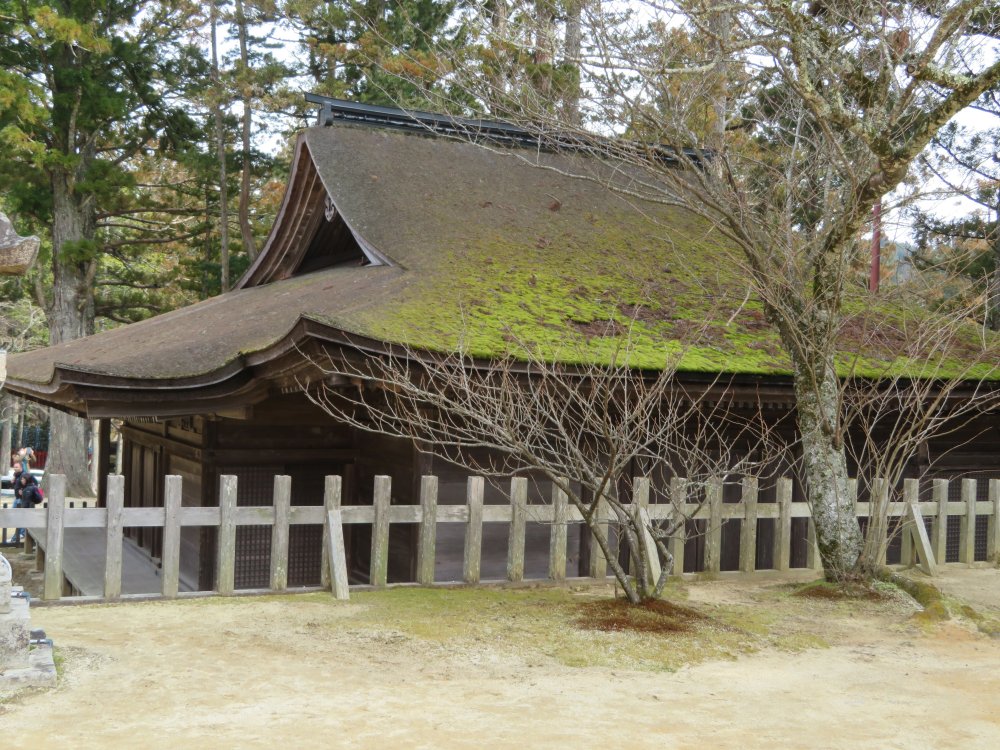
Fudoudou has features of a nobleman’s house of the late Heian period.
We first toured the inside of the tall red pagoda, Konpon-daitou. Although from the outside the pagoda appears to be a two storey building, our guide showed us that it was only one storey. The main feature of the inside of the pagoda is a three dimensional mandala. Mandala is a Buddhist art portraying the main deity in the middle and other supporting holy figures surrounding it. It is typically seen as a wall painting or tapestry, but can be portrayed three dimensionally with Buddhist statues as in this case. A classic example can be seen in Touji Temple in Kyoto. Touji temple is the head temple of the Shingon esoteric Buddhism.
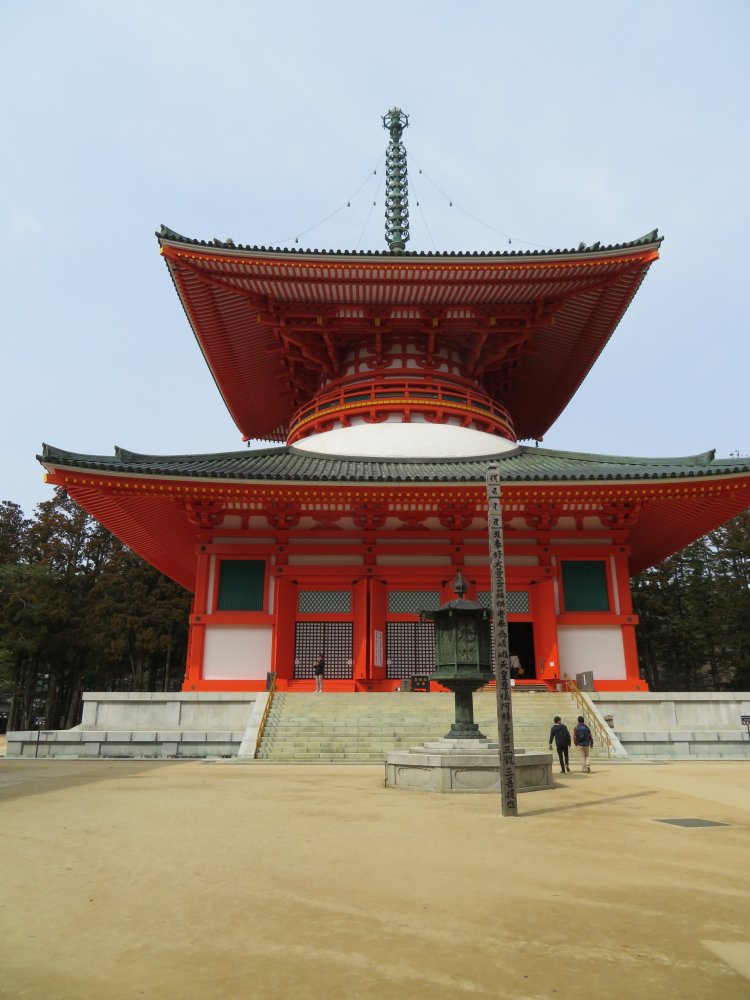
The main feature of the inside of the pagoda is a three dimensional mandala.
In front of the Kondou (main temple) there is a pine tree. This is where the tool Kuukai threw from China landed according to legend. The pine tree is unique and has three spike leaves instead of the usual two or five spikes. The three spike leaves are considered to be a luck charm and we noted some visitors picking some up. From there we took to the Jabara path leading to Kongoubuji Temple. Jabara means “snake belly” and the path has been so named because of the resemblance.
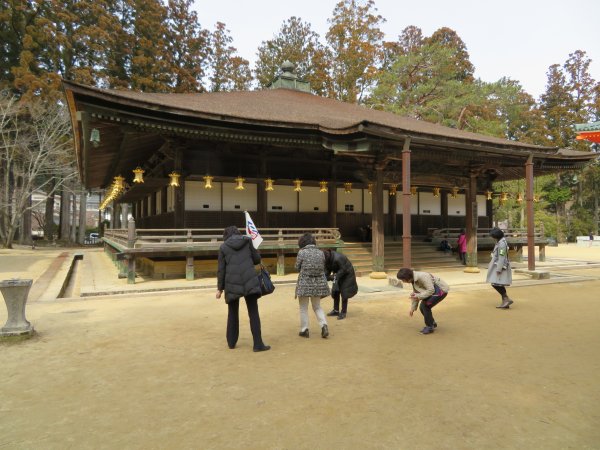
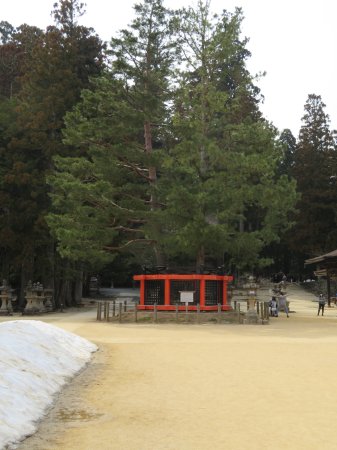
Visitors search in front of the Kondou (left) for three spike pine leaves from the legendary pine tree (right).
Kongoubuji Temple was founded in the early 9th century by Kuukai, but it was only after his lifetime that it was completed. During its long history many feudal lords funded the opening of new temples in memory of their beloved ones. The current Kongoubuji Temple in the narrower meaning (and as many understand) is a temple from the late 16th century that was funded by Hideyoshi Toyotomi who succeeded in uniting Japan after the Sengoku (civil war) era in memory of his mother. We enjoyed the tour of the large 50 meters by 60 meters main building. What you should not miss are the art on the fusuma (sliding door segregating the rooms) by master artists of the Kanou group of Hideyoshi’s period, the reception room for the Emperor and the room where Hideyoshi’s younger brother committed suicide. You will also enjoy the fabulous Japanese sand and rock garden, Hanryuutei. Hanryuutei means the garden of cricket (insect) and dragon. Our guide pointed out to a range of rocks depicting two dragons. I do not recall her telling us where the cricket was.

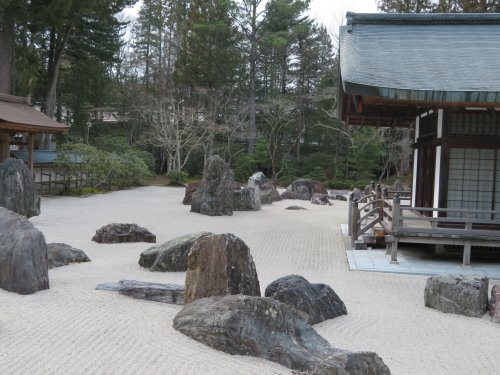
The hondou of Kongoubuji Temple (left) and its picturesque Hanryuutei Garden (left)
The finale of our tour was a visit to Okunoin. This is the area that Kuukai chose as his burial place. As Kuukai is thought to have achieved awareness of the universe (satori) and gained immortality by doing so, he is believed to be present to this day. Twice a day, food has continued to be offered to him. It is about two kilometers from the entrance gate to the mausoleum of Kuukai at the far back. Along the paths leading to the mausoleum lies over 200,000 memorials and graves of prominent people and families from all around Japan including many famous feudal lords. Kouyasan has been regarded as many to be the paradise in Buddhism. So it is no wonder people contributed to have these memorials and graves for their beloved ones so they would rest in peace. The paths go through a cedar forest many of which are more than 500 years old. The moment you enter the area, you cannot help but get a solemn feel from the fresher air and tranquility.
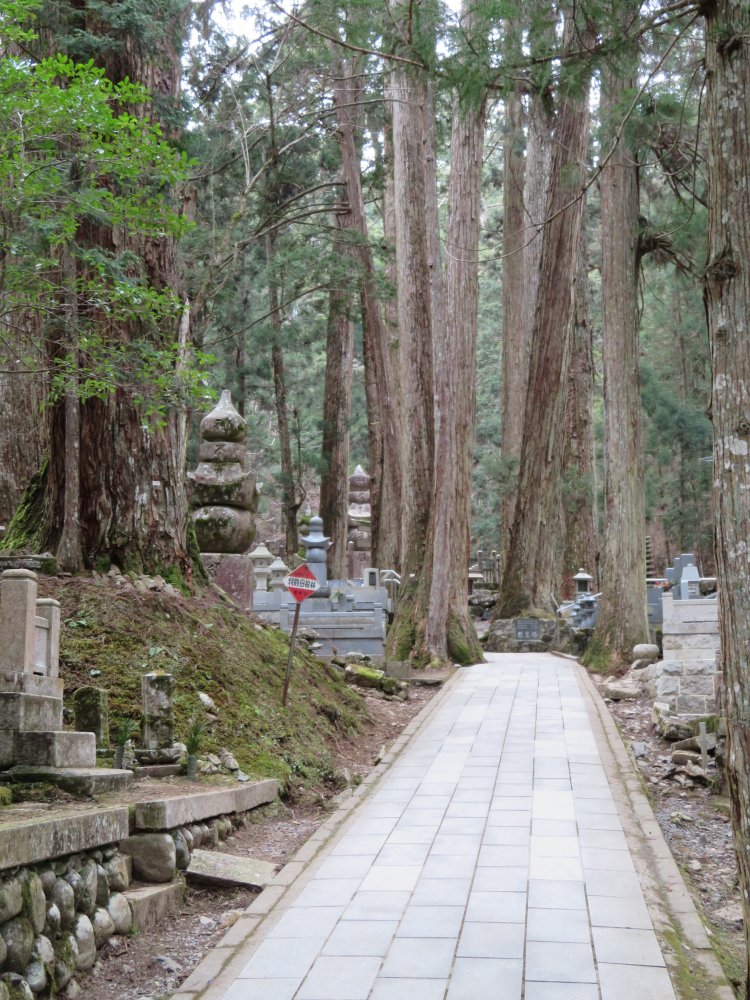
You cannot help but get a solemn feel from the fresher air and tranquility.
There is a sacred bridge (Gobyounohashi) just before Kuukai’s mausoleum. From that point you need to take off your hats in respect and are forbid to take any photos. You are allowed to pay your respects at the altar on the main floor as well as that in the basement. It was a very busy three day tour of Ise-jinguu, Kumano Sanzan and Kouyasan, but very rewarding for me in my quest to rediscover Japan. It is certainly a tour I would recommend to visitors interested in the religious side of Japan.

Kuukai's mausoleum viewed from Gobyounohashi bridge